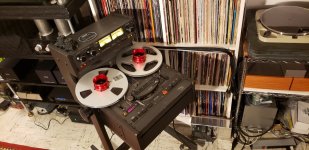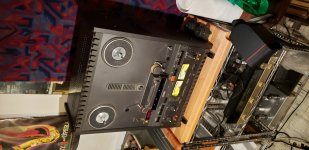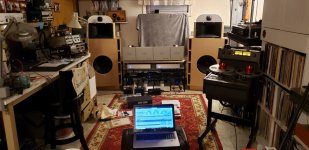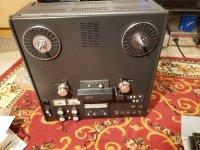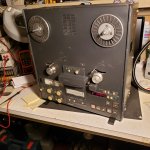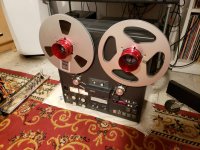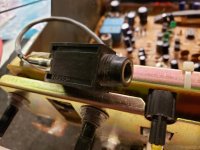Hi Kevin,
You're doing a bang-up job on those R-R machines. I predict some money making projects for you in the future!
-Chris
You're doing a bang-up job on those R-R machines. I predict some money making projects for you in the future!
-Chris
I'm curious---what sort of $$$ are we talkin' here to pickup these decks?I hate to admit it but I just purchased a broken MX-50NII a few days ago. Audio path is much simpler but amenable to most of the same modifications I have made on the two MX-5050 I own.
Anywhere from free to $2K+ depending on what the seller thinks their deck is worth and what you are willing to pay.
MX-55N and MTR-10/12 tend to command rather hefty prices. The 55 is quite rare.
MX-55N and MTR-10/12 tend to command rather hefty prices. The 55 is quite rare.
I now also own two MX-50N, the first one needs a lot work, but sounded good enough to persuade me to purchase a really nice one.
The first one shown arrived today and is a very mint MX-50N II which needs an electronic refresh. (Caps replaced and some other minor ministrations.)
The second one shown arrived last week and was involved in some sort of mishap that resulted in it getting wet. The reel tables and table holders are unserviceable due to damage and it currently has MX-5050 reel tables and holders on it. It does run, and is currently is in lots of pieces as I assess and repair damage. Recap will be soon.
I would frankly recommend a well cared for MX-50 for anyone not willing to do the mods discussed in this thread. It sounds pretty good out of the box and has a transport that is much gentler on fragile tapes. On the down side it lacks oscillator and external calibration controls for recording and you have to take the bottom off to do the calibration. The machine does not have the macho industrial look of the 5050, they are contemporaries of very late BII/MKIII and early BIII.
The first one shown arrived today and is a very mint MX-50N II which needs an electronic refresh. (Caps replaced and some other minor ministrations.)
The second one shown arrived last week and was involved in some sort of mishap that resulted in it getting wet. The reel tables and table holders are unserviceable due to damage and it currently has MX-5050 reel tables and holders on it. It does run, and is currently is in lots of pieces as I assess and repair damage. Recap will be soon.
I would frankly recommend a well cared for MX-50 for anyone not willing to do the mods discussed in this thread. It sounds pretty good out of the box and has a transport that is much gentler on fragile tapes. On the down side it lacks oscillator and external calibration controls for recording and you have to take the bottom off to do the calibration. The machine does not have the macho industrial look of the 5050, they are contemporaries of very late BII/MKIII and early BIII.
Attachments
MX-50N (Water Damage)
Here is the deck in its last running configuration and as it currently sits.
I have to my chagrin discovered that the audio board actually got wet, and there is evidence of some sort of contamination mixed with what appears to be rosin. This coating is on all of the boards and nowhere else - I am how it got there.
There is some very minor corrosion damage on the bottom of the board.
The logic board has the same stuff on the back side as well.
The plan is to clean these boards thoroughly and replace all of the electrolytics. They are much less trivial to take apart than the MKIII, but perhaps not quite as bad as the BII, bearing in mind I have not tried to put it back together yet.
It sounded quite good while it was actually running.
Here is the deck in its last running configuration and as it currently sits.
I have to my chagrin discovered that the audio board actually got wet, and there is evidence of some sort of contamination mixed with what appears to be rosin. This coating is on all of the boards and nowhere else - I am how it got there.
There is some very minor corrosion damage on the bottom of the board.
The logic board has the same stuff on the back side as well.
The plan is to clean these boards thoroughly and replace all of the electrolytics. They are much less trivial to take apart than the MKIII, but perhaps not quite as bad as the BII, bearing in mind I have not tried to put it back together yet.
It sounded quite good while it was actually running.
Attachments
-
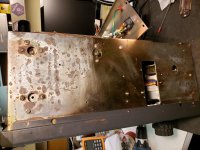 20190701_203220.jpg411.4 KB · Views: 145
20190701_203220.jpg411.4 KB · Views: 145 -
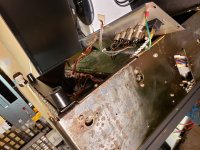 20190701_203225.jpg416.1 KB · Views: 139
20190701_203225.jpg416.1 KB · Views: 139 -
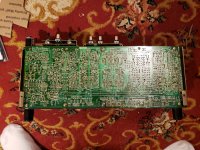 20190701_204656.jpg618.6 KB · Views: 143
20190701_204656.jpg618.6 KB · Views: 143 -
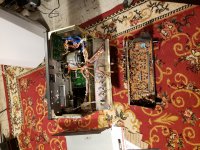 20190701_222414.jpg611 KB · Views: 158
20190701_222414.jpg611 KB · Views: 158 -
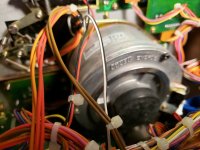 20190701_211616.jpg296 KB · Views: 139
20190701_211616.jpg296 KB · Views: 139 -
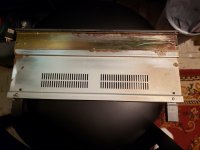 20190701_201346.jpg304.6 KB · Views: 147
20190701_201346.jpg304.6 KB · Views: 147 -
 20190701_211631.jpg614.3 KB · Views: 142
20190701_211631.jpg614.3 KB · Views: 142 -
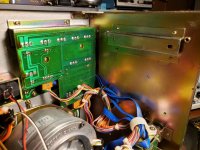 20190701_211626.jpg444.1 KB · Views: 160
20190701_211626.jpg444.1 KB · Views: 160 -
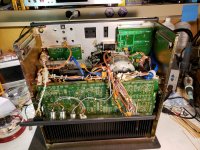 20190701_204619.jpg589.1 KB · Views: 161
20190701_204619.jpg589.1 KB · Views: 161 -
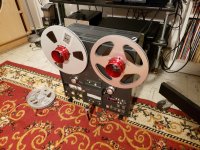 20190629_192524.jpg535 KB · Views: 153
20190629_192524.jpg535 KB · Views: 153
Hi Kevin,
Your MX-50N reminds me of working on the Tascam 80-8 in some ways.
The PCBs don't look too bad. The metalwork somewhat worse. I'm sure that electrically it will clean up fine. Some of the metal will need a good sanding. A repaint after sandblast would make it look new-ish again. I'm pretty sure tht it will perform very well once you're done Kevin.
-Chris
Your MX-50N reminds me of working on the Tascam 80-8 in some ways.
The PCBs don't look too bad. The metalwork somewhat worse. I'm sure that electrically it will clean up fine. Some of the metal will need a good sanding. A repaint after sandblast would make it look new-ish again. I'm pretty sure tht it will perform very well once you're done Kevin.
-Chris
They are not too difficult to take apart to service. The MKIII-2 is the clear winner in this regard if it is installed in a cart - just remove the audio module or flip it over to gain access to the transport electronics.
My MKIII-2 was destined for the scrap heap and after a lot of relatively easy and trivial work/modifications several of my friends agree it is the best sounding deck I have and overall is a pretty nice machine. It's biggest downside is it's not very gentle, I do plan to reduce reel motor torque a bit in the future.
The two MX-50N are more of an open question, my suspicion is that with the right heads and some additional mods they could top the performance of the current MX-5050 winner. (Or who knows, I'm not done with that one yet either... 😛 )
My MKIII-2 was destined for the scrap heap and after a lot of relatively easy and trivial work/modifications several of my friends agree it is the best sounding deck I have and overall is a pretty nice machine. It's biggest downside is it's not very gentle, I do plan to reduce reel motor torque a bit in the future.
The two MX-50N are more of an open question, my suspicion is that with the right heads and some additional mods they could top the performance of the current MX-5050 winner. (Or who knows, I'm not done with that one yet either... 😛 )
Hi Kevin,
I think it's always a good thing to try and improve one to see how far it goes in performance. If it turns out really well, #2 is now a known entity and modding it is merely following the same footsteps.
-Chris
I think it's always a good thing to try and improve one to see how far it goes in performance. If it turns out really well, #2 is now a known entity and modding it is merely following the same footsteps.
-Chris
Well after some listening it is pretty clear it is not quite in the same league as my modified MKIII-2, but we will see how far I can go with these decks. Most likely they would need comparable heads to the SAKI heads on the MKIII-2 and I am not sure whether I can procure more or not.
Edit: In direct comparison it's not all that close. The MKIII-2 is actually a lot better, but it has special heads and rather a lot of modifications. I hope to close the gap a bit at worst and achieve parity at best. I will perform the same modifications where applicable.
Edit: In direct comparison it's not all that close. The MKIII-2 is actually a lot better, but it has special heads and rather a lot of modifications. I hope to close the gap a bit at worst and achieve parity at best. I will perform the same modifications where applicable.
Hi Kevin,
I suspect you will achieve parity at least. You will make sure that you do!
Hey, I just got a wow & flutter meter! A Panasonic VP-7750P. 🙂
-Chris
I suspect you will achieve parity at least. You will make sure that you do!
Hey, I just got a wow & flutter meter! A Panasonic VP-7750P. 🙂
-Chris
Here is a shot of it running.
I ran it at both 7.5ips and 15ips and observed no problems.
Brakes do not work any better than MX-5050 even with the retrofit, but they do work.. Overall it is gentler to the tape, smoother and better damped switching between modes and stop.
I am now turning my focus to the MX-50N with water damage that I picked up a week ago. Just finished cleaning the bottom of the audio module PCB.
It is lovely to discover that I may have difficulty replacing the corroded headphone jack because apparently no one makes one anymore that fits and is isolated. I will have to keep looking.
I ran it at both 7.5ips and 15ips and observed no problems.
Brakes do not work any better than MX-5050 even with the retrofit, but they do work.. Overall it is gentler to the tape, smoother and better damped switching between modes and stop.
I am now turning my focus to the MX-50N with water damage that I picked up a week ago. Just finished cleaning the bottom of the audio module PCB.
It is lovely to discover that I may have difficulty replacing the corroded headphone jack because apparently no one makes one anymore that fits and is isolated. I will have to keep looking.
Attachments
Hi Kevin,
Nice!
How about a picture of the headphone jack. Also, if you need the isolation a more modern plastic jack might fit.
-Chris
Nice!
How about a picture of the headphone jack. Also, if you need the isolation a more modern plastic jack might fit.
-Chris
It was a very common part made by Hosiden so I'm going to have a look over at DigiKey and Mouser. I looked on eBay and did not find one, but I need to look some more.
It may even be salvageable but I'd prefer to replace it, the nut and washer are seriously corroded.
The sad irony is not too many years ago I am pretty confident I had a couple of these knocking around. Pretty sure I gave them away.
It may even be salvageable but I'd prefer to replace it, the nut and washer are seriously corroded.
The sad irony is not too many years ago I am pretty confident I had a couple of these knocking around. Pretty sure I gave them away.
Attachments
Hi Kevin,
I've seen a thousand of those on different pieces of equipment. It is entirely possible that they are NLA, but you could use the nut and washer off a different jack if you can clean that one up.
-Chris
I've seen a thousand of those on different pieces of equipment. It is entirely possible that they are NLA, but you could use the nut and washer off a different jack if you can clean that one up.
-Chris
I am wondering....WHAT, exactly, is better? Noise? Frequency response? Distortion? Transient response?Well after some listening it is pretty clear it is not quite in the same league as my modified MKIII-2.........In direct comparison it's not all that close. The MKIII-2 is actually a lot better, but it has special heads and rather a lot of modifications.
Hi dotneck335,
You forgot signal to noise ratio, speed stability ...
Actually, you first get the noise down, and it depends on the tape. There is usually an amount of over bias that will balance all those things you are talking about. The EQ is then corrected and the level as well. Now that you have it recording, you can chase the other details. Transient response is pretty much fixed by the tape as bias is usually in the area of 100 KHz, plus or minus.
So many of those things you asked about are fixed and we can't do a great deal about them. We can make the reproduce amp quieter with lower distortion, but the tape will have higher distortion and noise, so there are practical limits on how much you can improve something. I guess it depends on how bad things are before you start as to how far it can go.
The one thing that will be noticed first is frequency response and flatness. So, I guess by virtue of what will be noticed first, frequency response could be called the most important thing. Most of these machines will rec-reproduce up to 25 KHz. So rather better than a cassette deck.
Then you can get into erase ratio and other things that are way down the list of important things. If there is a problem with stuff like this you want to believe that problem would be the most important on the list at that moment.
-Chris
You forgot signal to noise ratio, speed stability ...
Actually, you first get the noise down, and it depends on the tape. There is usually an amount of over bias that will balance all those things you are talking about. The EQ is then corrected and the level as well. Now that you have it recording, you can chase the other details. Transient response is pretty much fixed by the tape as bias is usually in the area of 100 KHz, plus or minus.
So many of those things you asked about are fixed and we can't do a great deal about them. We can make the reproduce amp quieter with lower distortion, but the tape will have higher distortion and noise, so there are practical limits on how much you can improve something. I guess it depends on how bad things are before you start as to how far it can go.
The one thing that will be noticed first is frequency response and flatness. So, I guess by virtue of what will be noticed first, frequency response could be called the most important thing. Most of these machines will rec-reproduce up to 25 KHz. So rather better than a cassette deck.
Then you can get into erase ratio and other things that are way down the list of important things. If there is a problem with stuff like this you want to believe that problem would be the most important on the list at that moment.
-Chris
I am wondering....WHAT, exactly, is better? Noise? Frequency response? Distortion? Transient response?
The last three although I would admit I have not done a whole lot of measurement lately.
I hear no evidence that any of these decks have audible levels of wow&flutter, but being a mechanical system it is there.
So far I don't find any of these machines make absolutely audibly indistinguishable copies when A/B'd against the original source. Not scientific or blind, but level matched. The MKIII is by far the best in this regard, and it's audibly not perfect either.
Electrically they cannot match even the performance of a good 16 bit 48kHz digital recording chain, I'm under no illusion that this is in any sense close to even that level of accuracy, but it is fun to play with and with recordings originally made in an all analog signal chain it can eliminate vinyl as the delivery medium (if you are willing to pay for the limited selection of titles) with significant gains in performance provided that your copy was made from a decent master.
To do meaningful measurements against the standards means I need to invest coin in calibration tapes and that is coming, but it will mark the transition from playing around and having fun which is what I am doing right now to something more serious. Those tapes are seriously expensive and several are required for EACH speed.
Unfortunately since my plans do include designing, developing and testing a good tape pre-amplifier I will at some point have to move to purchase those tapes. (Some modifications I might like to try also would require them.)
Some comments on specifications which by today's standards are not impressive...
Bias frequency is 150kHz
SNR tops out at just under 70dB A weighted and requires high output tape recorded at the maximum levels permitted before tape saturation occurs. I use such a tape. (SM900)
Otari claims +/-2dB 30Hz - 20kHz for complementary recording/playback process to 3M 226 tape referenced to 1kHz. The SAKI heads are better than this but I was only looking to see whether the minimum specification was met. (It was) I used my uncalibrated Amber 3501A and a good voltmeter so I doubt I can do measurements to much better accuracy than this. I have not tried doing any measurements with the RTX.
Bias frequency is 150kHz
SNR tops out at just under 70dB A weighted and requires high output tape recorded at the maximum levels permitted before tape saturation occurs. I use such a tape. (SM900)
Otari claims +/-2dB 30Hz - 20kHz for complementary recording/playback process to 3M 226 tape referenced to 1kHz. The SAKI heads are better than this but I was only looking to see whether the minimum specification was met. (It was) I used my uncalibrated Amber 3501A and a good voltmeter so I doubt I can do measurements to much better accuracy than this. I have not tried doing any measurements with the RTX.
- Home
- Source & Line
- Analogue Source
- So you think you want to play with tape: An Otari Story
